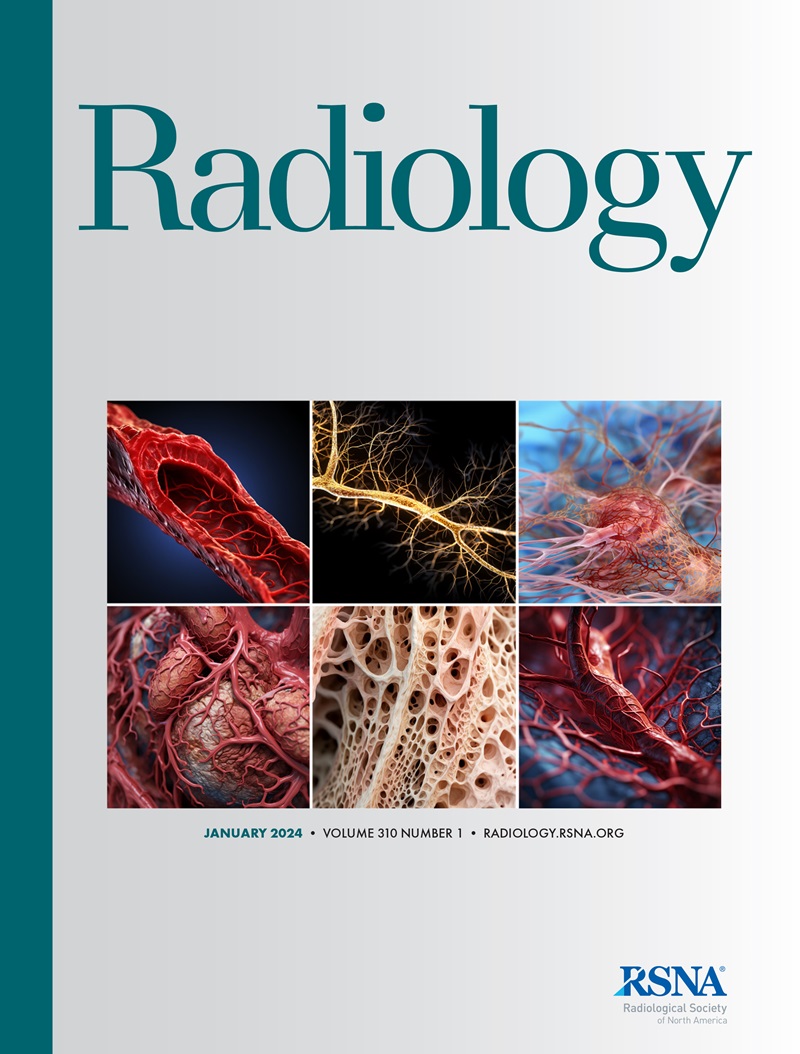Sophie E L van Grinsven, Ritse M Mann, Evelyn M Monninkhof, Katya Duvivier, Mathijn D F de Jong, Petra K de Koekkoek-Doll, Claudette E Loo, Ruud M Pijnappel, Rogier van der Sluijs, Jeroen Veltman, Carla H van Gils, Wouter B Veldhuis
求助PDF
{"title":"短缩乳腺MRI对乳腺极致密女性的多读诊断准确性。","authors":"Sophie E L van Grinsven, Ritse M Mann, Evelyn M Monninkhof, Katya Duvivier, Mathijn D F de Jong, Petra K de Koekkoek-Doll, Claudette E Loo, Ruud M Pijnappel, Rogier van der Sluijs, Jeroen Veltman, Carla H van Gils, Wouter B Veldhuis","doi":"10.1148/radiol.241233","DOIUrl":null,"url":null,"abstract":"<p><p>Background Abbreviated MRI may reduce costs and time of supplemental breast cancer screening. The Dense Tissue and Early Breast Neoplasm Screening (DENSE) trial provides an opportunity to study this protocol in a true screening population. Purpose To compare multireader diagnostic accuracy of various abbreviated screening breast MRI protocols with that of the full multiparametric protocol in the DENSE trial, focusing on identifying the minimal protocol necessary to maintain high diagnostic accuracy. Materials and Methods In this secondary analysis of a subset from the DENSE trial, seven radiologists performed incremental readings of first-round screening MRI scans in women with extremely dense breasts and findings negative for cancer at mammography. Different sequences were added in four incremental steps. The first step included both high-temporal low-spatial and low-temporal high-spatial dynamic T1-weighted series, up to 120 seconds after contrast agent injection. The final step added all full-protocol sequences. Each radiologist assessed the same MRI scans and provided Breast Imaging Reporting and Data System scores for all four incremental steps. Pooled sensitivity and specificity were calculated across all readers per step using a generalized estimating equation model, and pooled reading time per step was calculated using a linear mixed model. Results The first-round screening included 518 MRI scans from 518 women (median age, 53 years; IQR, 51-59 years), including 83 breast cancers: 68 invasive cancers (82%) and 15 ductal carcinomas in situ (18%). There was no evidence of a difference in sensitivity between abbreviated protocol (84.3%; 95% CI: 77.7, 89.2) and the full multiparametric MRI protocol (85.9%; 95% CI: 80.0, 90.3; <i>P</i> = .68). There was also no evidence of a difference in specificity between abbreviated protocol (73.9%; 95% CI: 70.7, 76.9) and full protocol (75.8%; 95% CI: 72.8, 78.5; <i>P</i> = .39). The abbreviated protocol had a pooled reading time (49.7 seconds; 95% CI: 48.5, 50.9) that was almost 50% shorter than the full protocol (96.4 seconds; 95% CI: 94.3, 98.5; <i>P</i> < .001) with 70%-80% shorter scanning time, depending on hospital and scanner vendor. Conclusion In women in the DENSE trial with extremely dense breasts and findings that were negative for cancer at mammography, abbreviated breast MRI for first-round screening had high diagnostic accuracy that was comparable to full multiparametric protocol, at much shorter reading and scanning times. ClinicalTrials.gov Identifier: NCT01315015 © RSNA, 2025 <i>Supplemental material is available for this article.</i> See also the editorial by Kataoka and Honda in this issue.</p>","PeriodicalId":20896,"journal":{"name":"Radiology","volume":"315 2","pages":"e241233"},"PeriodicalIF":15.2000,"publicationDate":"2025-05-01","publicationTypes":"Journal Article","fieldsOfStudy":null,"isOpenAccess":false,"openAccessPdf":"","citationCount":"0","resultStr":"{\"title\":\"Multireader Diagnostic Accuracy of Abbreviated Breast MRI for Screening Women with Extremely Dense Breasts.\",\"authors\":\"Sophie E L van Grinsven, Ritse M Mann, Evelyn M Monninkhof, Katya Duvivier, Mathijn D F de Jong, Petra K de Koekkoek-Doll, Claudette E Loo, Ruud M Pijnappel, Rogier van der Sluijs, Jeroen Veltman, Carla H van Gils, Wouter B Veldhuis\",\"doi\":\"10.1148/radiol.241233\",\"DOIUrl\":null,\"url\":null,\"abstract\":\"<p><p>Background Abbreviated MRI may reduce costs and time of supplemental breast cancer screening. The Dense Tissue and Early Breast Neoplasm Screening (DENSE) trial provides an opportunity to study this protocol in a true screening population. Purpose To compare multireader diagnostic accuracy of various abbreviated screening breast MRI protocols with that of the full multiparametric protocol in the DENSE trial, focusing on identifying the minimal protocol necessary to maintain high diagnostic accuracy. Materials and Methods In this secondary analysis of a subset from the DENSE trial, seven radiologists performed incremental readings of first-round screening MRI scans in women with extremely dense breasts and findings negative for cancer at mammography. Different sequences were added in four incremental steps. The first step included both high-temporal low-spatial and low-temporal high-spatial dynamic T1-weighted series, up to 120 seconds after contrast agent injection. The final step added all full-protocol sequences. Each radiologist assessed the same MRI scans and provided Breast Imaging Reporting and Data System scores for all four incremental steps. Pooled sensitivity and specificity were calculated across all readers per step using a generalized estimating equation model, and pooled reading time per step was calculated using a linear mixed model. Results The first-round screening included 518 MRI scans from 518 women (median age, 53 years; IQR, 51-59 years), including 83 breast cancers: 68 invasive cancers (82%) and 15 ductal carcinomas in situ (18%). There was no evidence of a difference in sensitivity between abbreviated protocol (84.3%; 95% CI: 77.7, 89.2) and the full multiparametric MRI protocol (85.9%; 95% CI: 80.0, 90.3; <i>P</i> = .68). There was also no evidence of a difference in specificity between abbreviated protocol (73.9%; 95% CI: 70.7, 76.9) and full protocol (75.8%; 95% CI: 72.8, 78.5; <i>P</i> = .39). The abbreviated protocol had a pooled reading time (49.7 seconds; 95% CI: 48.5, 50.9) that was almost 50% shorter than the full protocol (96.4 seconds; 95% CI: 94.3, 98.5; <i>P</i> < .001) with 70%-80% shorter scanning time, depending on hospital and scanner vendor. Conclusion In women in the DENSE trial with extremely dense breasts and findings that were negative for cancer at mammography, abbreviated breast MRI for first-round screening had high diagnostic accuracy that was comparable to full multiparametric protocol, at much shorter reading and scanning times. ClinicalTrials.gov Identifier: NCT01315015 © RSNA, 2025 <i>Supplemental material is available for this article.</i> See also the editorial by Kataoka and Honda in this issue.</p>\",\"PeriodicalId\":20896,\"journal\":{\"name\":\"Radiology\",\"volume\":\"315 2\",\"pages\":\"e241233\"},\"PeriodicalIF\":15.2000,\"publicationDate\":\"2025-05-01\",\"publicationTypes\":\"Journal Article\",\"fieldsOfStudy\":null,\"isOpenAccess\":false,\"openAccessPdf\":\"\",\"citationCount\":\"0\",\"resultStr\":null,\"platform\":\"Semanticscholar\",\"paperid\":null,\"PeriodicalName\":\"Radiology\",\"FirstCategoryId\":\"3\",\"ListUrlMain\":\"https://doi.org/10.1148/radiol.241233\",\"RegionNum\":1,\"RegionCategory\":\"医学\",\"ArticlePicture\":[],\"TitleCN\":null,\"AbstractTextCN\":null,\"PMCID\":null,\"EPubDate\":\"\",\"PubModel\":\"\",\"JCR\":\"Q1\",\"JCRName\":\"RADIOLOGY, NUCLEAR MEDICINE & MEDICAL IMAGING\",\"Score\":null,\"Total\":0}","platform":"Semanticscholar","paperid":null,"PeriodicalName":"Radiology","FirstCategoryId":"3","ListUrlMain":"https://doi.org/10.1148/radiol.241233","RegionNum":1,"RegionCategory":"医学","ArticlePicture":[],"TitleCN":null,"AbstractTextCN":null,"PMCID":null,"EPubDate":"","PubModel":"","JCR":"Q1","JCRName":"RADIOLOGY, NUCLEAR MEDICINE & MEDICAL IMAGING","Score":null,"Total":0}
引用次数: 0
引用
批量引用

 求助内容:
求助内容: 应助结果提醒方式:
应助结果提醒方式:


